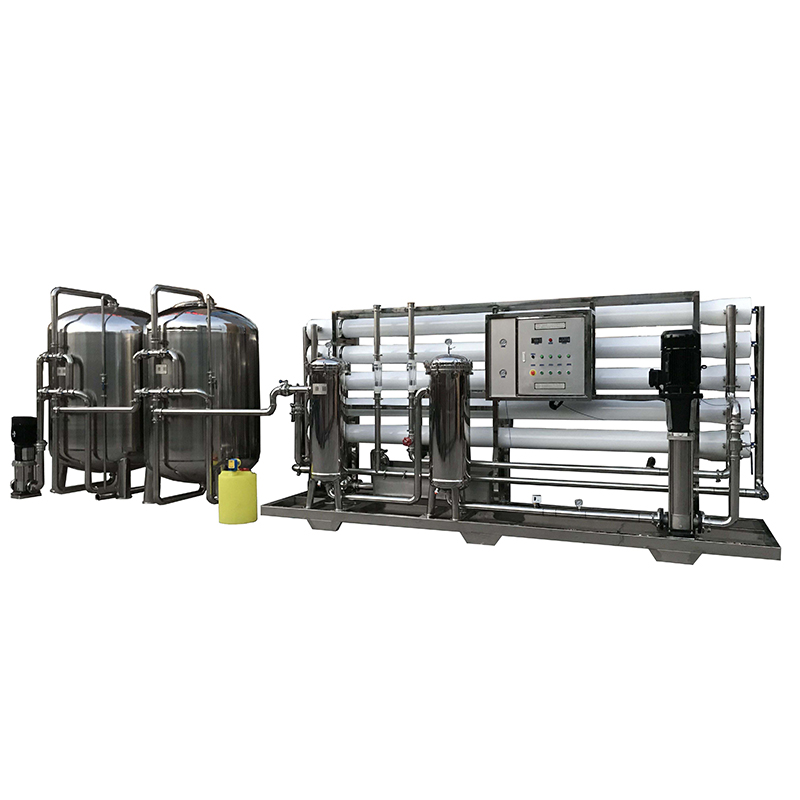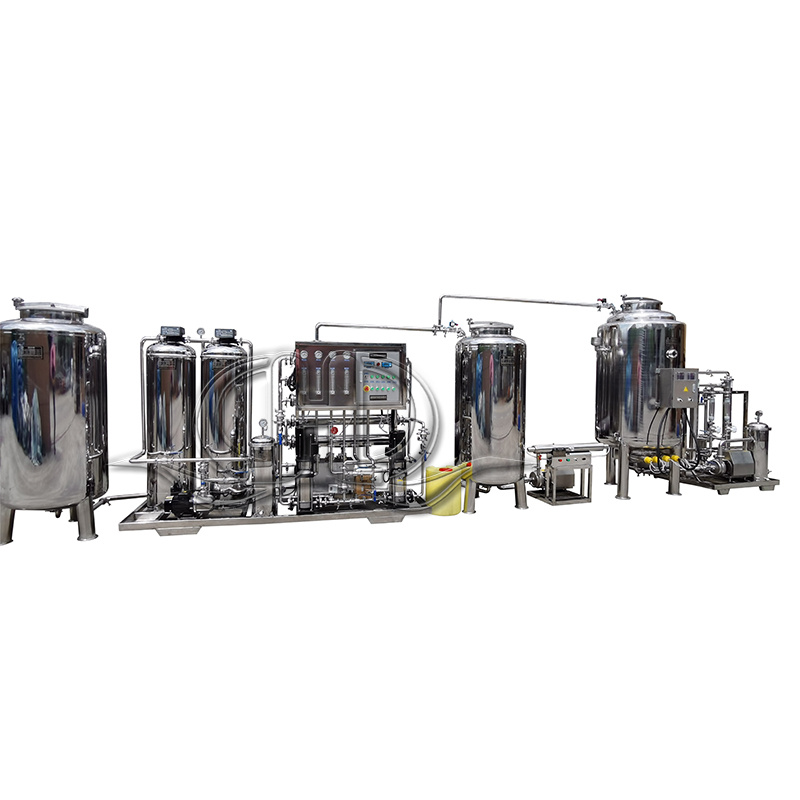Fully Automatic Ultraviolet Purification Water Belt Stainless Steel Water tank Water Treatment Equipment
Product description
1、 Core components and functions
1. Fully Automatic Ultraviolet Purification System
Disinfection principle:
By irradiating water with ultraviolet (UV) lamps (wavelength 254nm), the DNA/RNA structure of microorganisms (bacteria, viruses, algae) is destroyed, causing them to lose their reproductive ability and achieving efficient sterilization (sterilization rate ≥ 99.9%).
Automated design:
Equipped with a light intensity sensor, it monitors the intensity of ultraviolet radiation in real time. When the intensity is lower than the set value (such as 30mJ/cm ²), it automatically alarms and prompts to replace the lamp (with a lifespan of about 8000-12000 hours).
It can be linked with a water flow switch to activate the ultraviolet lamp only when there is water flow, saving energy consumption.
Applicable scenarios:
Suitable for scenarios with strict requirements for microbial indicators, such as drinking water, food processing water, pharmaceutical purified water, etc.
2. Stainless Steel Water Tank
Material and Structure:
Made of 304 or 316L stainless steel, with inner wall electrolytic polishing (roughness Ra ≤ 0.6 μ m), corrosion-resistant, easy to clean, and in compliance with food grade standards (such as FDA, NSF 61).
The design includes an air respirator (0.22 μ m sterilization filter), a spray cleaning system (CIP automatic cleaning), a liquid level gauge (ultrasonic or magnetic flap), and a drain valve.
Function:
Store purified water to prevent secondary pollution;
The volume can be customized (1-1000m ³) to meet the water needs of different scales.
3. Other auxiliary equipment (water treatment module)
Preprocessing unit (optional):
Quartz sand filter: removes suspended solids and sediment (turbidity ≤ 5NTU);
Activated carbon filter: adsorbs residual chlorine and organic matter (residual chlorine ≤ 0.1mg/L);
Precision filter: filtration accuracy of 5 μ m, intercepting fine particles.
Boosting pump and control system:
Stainless steel centrifugal pump provides water transmission power, with variable frequency control (energy-saving 20% -30%);
PLC fully automatic control system, real-time monitoring of water quality (such as conductivity, UV intensity, liquid level), supports remote monitoring (such as Modbus protocol).
2、 System Process and Technical Characteristics
1. Typical processing flow
plaintext
Raw water → Pre treatment (sand filtration+carbon filtration+precision filtration) → UV sterilization → Stainless steel water tank → Water point
perhaps
plaintext
Purified water (such as RO produced water) → UV sterilization → Stainless steel water tank → Water point
2. Core technological advantages
Characteristic technology implementation
Efficient and residue free sterilization, UV directly acts on microbial DNA without the need for chemical agents, avoiding secondary pollution such as residual chlorine.
Highly automated UV lamp lifespan monitoring, water tank level control, CIP cleaning fully automated, reducing labor costs.
Strong water quality assurance capability, stainless steel water tank eliminates material pollution, air respirator prevents external microorganisms from invading, suitable for sterile environment.
Durable and economical stainless steel material has a service life of ≥ 15 years, and the cost of replacing ultraviolet lamps is low (about 500-1000 yuan per lamp).
3、 Application scenarios
1. Drinking water treatment
Direct drinking water system in residential areas:
The raw water is pre treated and sterilized by ultraviolet radiation before being stored in a stainless steel water tank. The produced water meets the GB 5749 standard and can be consumed directly.
Rural Safe Drinking Water Project:
Groundwater undergoes sand filtration and ultraviolet sterilization to remove bacteria and colloids, solving the problem of excessive microbial growth.
2. Food and beverage industry
Sterilization of production water:
Used for beverage preparation and equipment cleaning, ensuring that microbial indicators (total bacterial count ≤ 10CFU/mL) comply with GB 12695 “Hygienic Standards for Beverage Plants”.
Aseptic water tank matching:
Used in conjunction with reverse osmosis systems to store high-purity water and meet the requirements of sterile filling lines.
3. Pharmaceutical and cosmetics industry
Purified water storage:
Stainless steel water tank+UV sterilization to prevent microbial growth (≤ 10CFU/100mL) during storage of purified water (in accordance with the Chinese Pharmacopoeia).
Cosmetics raw material water:
Remove bacteria and organic matter to ensure product stability and safety.
4. Industrial circulating water and landscape water
Sterilization of circulating cooling water:
Inhibit microbial growth, reduce sediment deposition, replace traditional chemical sterilization (such as chlorine gas), and reduce equipment corrosion risk.
Landscape pool purification:
Ultraviolet rays kill algae and bacteria, maintain clear water quality, and reduce the frequency of water changes.
4、 Key points of design and selection
1. UV module design parameters
Lamp power: selected according to flow rate (such as processing 10m ³/h water, 40W x 4 lamps are required);
Exposure intensity: ≥ 30mJ/cm ² (ensuring sterilization rate ≥ 99.9%);
Water flow velocity: ≤ 1.5m/s (too fast flow velocity will reduce UV exposure time).
2. Design standards for stainless steel water tanks
Volume calculation: determined based on the peak water usage (e.g. peak flow rate of 20m ³/h, water tank volume needs to be ≥ 30m ³);
Pressure rating: atmospheric water tank (0.1MPa) or pressurized water tank (0.3-0.6MPa, pressure transmitter required);
Cleaning frequency: CIP automatic cleaning once a week (80 ℃ hot water+0.1% citric acid solution).
3. System integration suggestions
Preprocessing adaptation:
High turbidity raw water: adding flocculation and sedimentation tanks;
High residual chlorine raw water: pre activated carbon filter or adding reducing agent (such as sodium bisulfite).
Energy saving configuration:
UV lamp group grouping control, adjust the number of turns on according to the flow rate;
The water tank adopts insulation layer (polyurethane foam) to reduce water temperature fluctuations and energy loss.
5、 Maintenance and troubleshooting
1. Daily maintenance checklist
Component maintenance content cycle
Clean the dust on the surface of the ultraviolet lamp tube and test the irradiation intensity monthly
Inspect the corrosion of the inner wall of the stainless steel water tank and clean the drain valve quarterly
Pre treatment filter backwash sand filter/carbon filter, replace precision filter element 1-3 months
Control system calibration sensors, backup PLC program every six months
2. Common faults and solutions
Possible causes and solutions for the fault phenomenon
Insufficient UV intensity, aging of lamp tube/surface scaling, replacement of lamp tube/wiping of lamp tube with alcohol
The water quality of the water tank is clogged with bacteria and the filter element of the air respirator is not thoroughly cleaned. Replace the filter element and increase the frequency of CIP cleaning
Abnormal operation of water pump, impeller blockage/motor overheating, cleaning of impeller/inspection of cooling fan
Control system alarm, liquid level sensor malfunction/UV lamp malfunction, calibration sensor/replacement of lamp tube
6、 Environmental and safety precautions
UV protection:
The equipment needs to be equipped with protective covers to avoid direct exposure of personnel to ultraviolet radiation (which may cause skin burns or eye damage).
Chemical agent management:
If equipped with a pre-treatment dosing device, the chemicals need to be classified and stored, and the waste liquid should be handed over to a professional organization for treatment to avoid environmental pollution.
Waste liquid from water tank cleaning:
The acidic/alkaline waste liquid generated by CIP cleaning needs to be neutralized to pH 6-9 before discharge, in accordance with GB 8978 “Comprehensive Wastewater Discharge Standard”.
summarize
This fully automatic ultraviolet water purification equipment provides a reliable microbial control solution for industries such as drinking water, food, and medicine through the combination of “efficient sterilization+safe storage”. The combination of the corrosion resistance of stainless steel water tanks and the residual sterilization advantage of ultraviolet radiation ensures that water quality continues to meet standards during storage and transportation. Its automated design and low operation and maintenance costs make it an ideal choice for scenarios with strict hygiene requirements. At the same time, by flexibly adapting the pretreatment unit, it can meet the purification needs of different raw water qualities.







